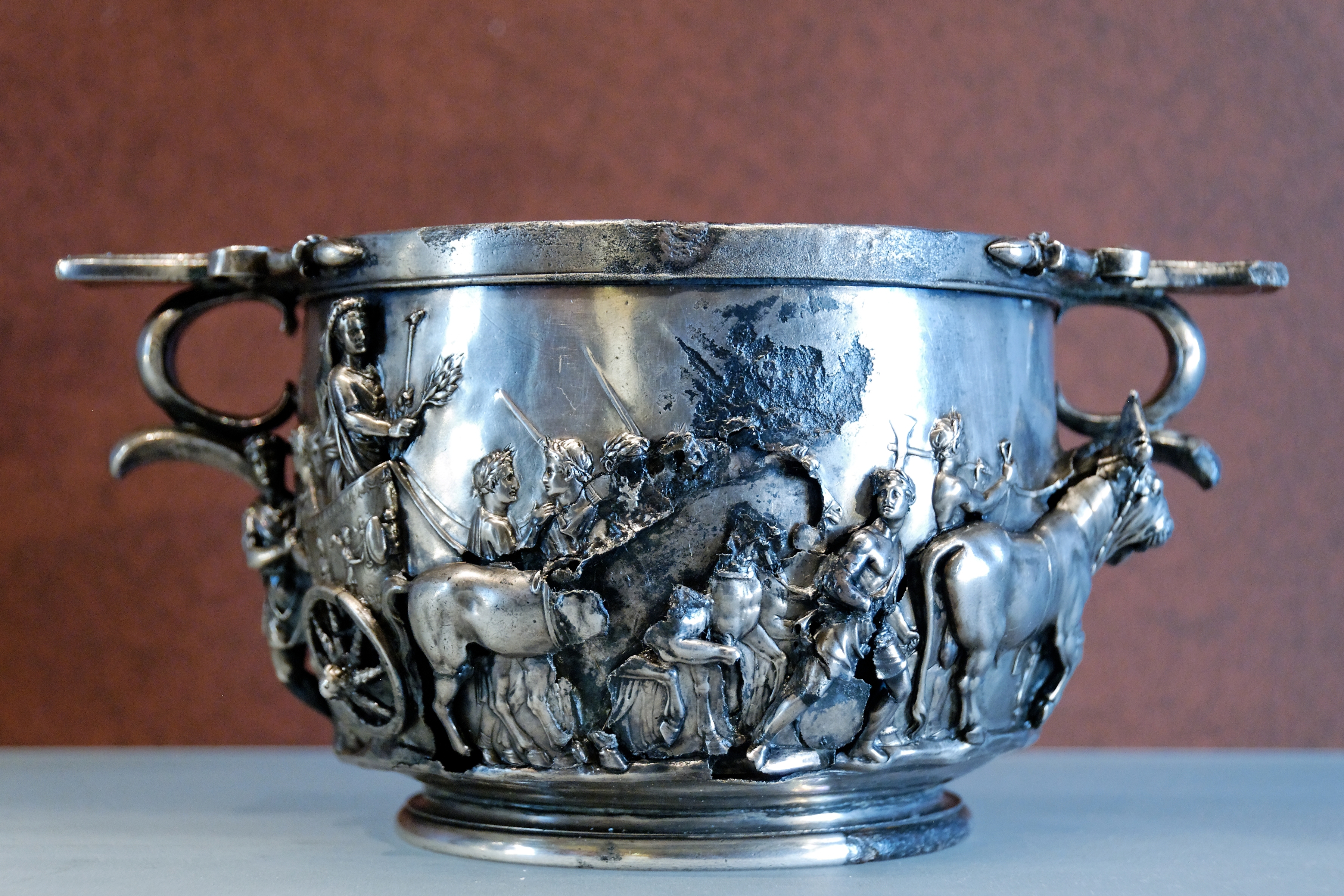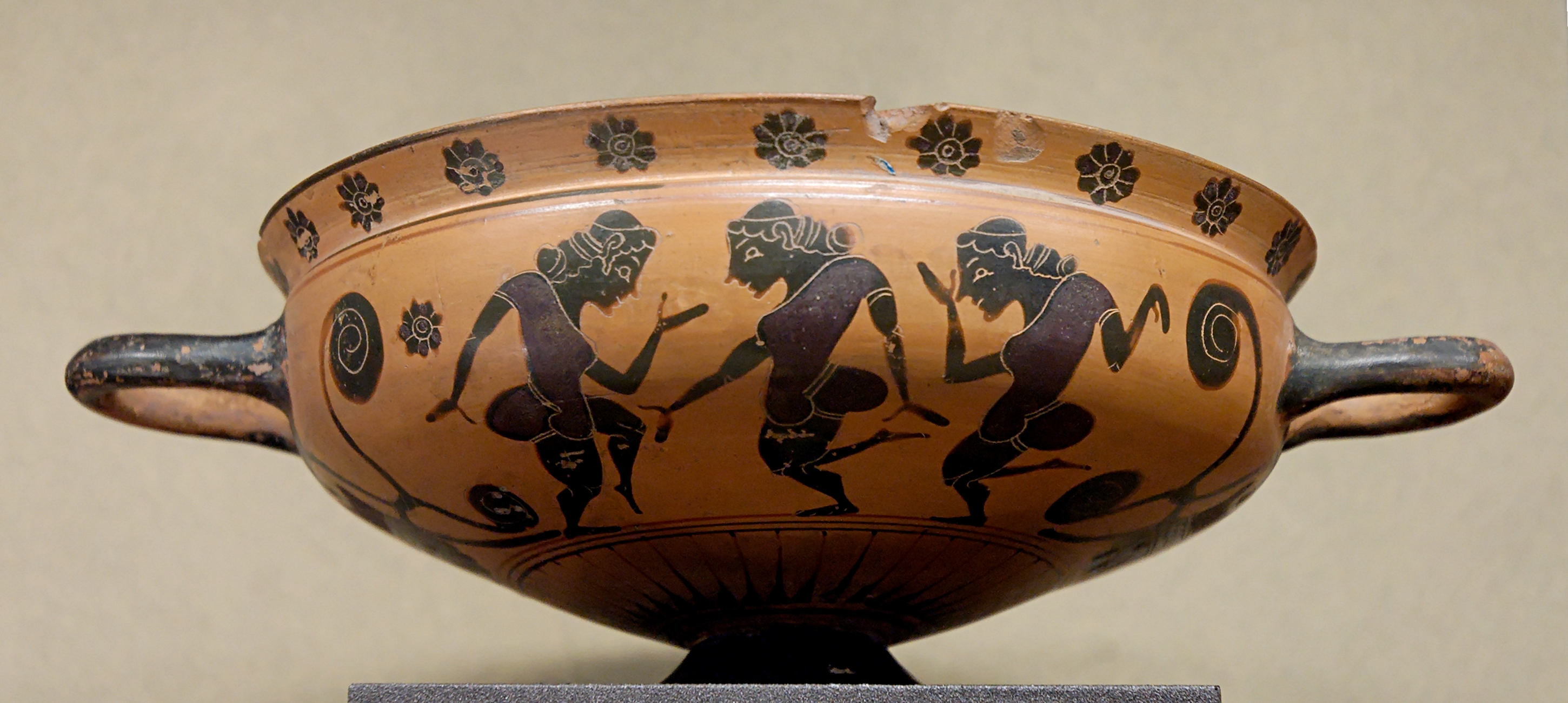|
KX Painter
The KX Painter was an Attic black-figure vase painter. He was active between 585 and 570 BC. Besides the KY Painter, the KX Painter was the main representative of the Comast Group, which succeeded the Gorgon Painter. His conventional name was allocated by John Beazley. He is considered the better and chronologically somewhat earlier representative of the group. He was the first painter in Athens to occasionally depict komasts on his vases, a motif adopted from Corinthian vase painting. He mainly painted '' skyphoi'', '' lekanes'', '' kothones'' and Komast cups. In contrast to later representatives of the group, he still mostly painted animals, in a more careful and powerful style than the Gorgon Painter. Some mythological scenes by him are also known. Especially famous are his small-fornat mythical scenes placed within animal friezes. The KX Painter can be considered the first Attic painter to achieve a quality at par with that reached in Corinth, then the dominant centre of ... [...More Info...] [...Related Items...] OR: [Wikipedia] [Google] [Baidu] |
Tripod Exaleiptron Louvre CA927
A tripod is a portable three-legged frame or stand, used as a platform for supporting the weight and maintaining the stability of some other object. The three-legged (triangular stance) design provides good stability against gravitational loads as well as horizontal shear forces, and better leverage for resisting tipping over due to lateral forces can be achieved by spreading the legs away from the vertical centre. Variations with one, two, and four legs are termed ''monopod'', ''bipod'', and ''quadripod'' (similar to a table). Etymology First attested in English in the early 17th century, the word ''tripod'' comes via Latin ''tripodis'' (GEN of ''tripus''), which is the romanization of Greek (''tripous''), "three-footed" (GEN , ''tripodos''), ultimately from (''tri-''), "three times" (from , ''tria'', "three") + (''pous''), "foot". The earliest attested form of the word is the Mycenaean Greek , ''ti-ri-po'', written in Linear B syllabic script. Cultural use Many cultur ... [...More Info...] [...Related Items...] OR: [Wikipedia] [Google] [Baidu] |
Skyphos
A ''skyphos'' ( grc, σκύφος; plural ''skyphoi'') is a two-handled deep wine-cup on a low flanged base or none. The handles may be horizontal ear-shaped thumbholds that project from the rim (in both Corinthian and Athenian shapes), or they may be loop handles at the rim or that stand away from the lower part of the body. ''Skyphoi'' of the type called '' glaux'' (owl) have one horizontal and one vertical thumbhold handle. Examples Early ''skyphoi'' were made during the Geometric period. Corinth set the conventions that Athens followed. Over a long period the shape remained the same while the style of decoration changed. ''Skyphoi'' were also made of precious metals, generally silver and gold leaf, many examples exist. One possible, well-preserved example is the Warren cup,In his notes, John Pollini states that uncertainty about the correct name of many ancient drinking vessels exists, however he refers to the object with the "established classificatory term scyphus", Specif ... [...More Info...] [...Related Items...] OR: [Wikipedia] [Google] [Baidu] |
Boeotia
Boeotia ( ), sometimes Latinized as Boiotia or Beotia ( el, Βοιωτία; modern: ; ancient: ), formerly known as Cadmeis, is one of the regional units of Greece. It is part of the region of Central Greece. Its capital is Livadeia, and its largest city is Thebes. Boeotia was also a region of ancient Greece, from before the 6th century BC. Geography Boeotia lies to the north of the eastern part of the Gulf of Corinth. It also has a short coastline on the Gulf of Euboea. It bordered on Megaris (now West Attica) in the south, Attica in the southeast, Euboea in the northeast, Opuntian Locris (now part of Phthiotis) in the north and Phocis in the west. The main mountain ranges of Boeotia are Mount Parnassus in the west, Mount Helicon in the southwest, Cithaeron in the south and Parnitha in the east. Its longest river, the Cephissus, flows in the central part, where most of the low-lying areas of Boeotia are found. Lake Copais was a large lake in the center of Boeotia. It was ... [...More Info...] [...Related Items...] OR: [Wikipedia] [Google] [Baidu] |
Ancient Corinth
Corinth (American English: ) (British English: ) ; grc-gre, Κόρινθος ; grc, label=Doric Greek, Ϙόρινθος; la, label=Latin, Corinthus) was a city-state (''polis'') on the Isthmus of Corinth, the narrow stretch of land that joins the Peloponnese to the mainland of Greece, roughly halfway between Athens and Sparta. The modern city of Corinth is located approximately northeast of the ancient ruins. Since 1896, systematic archaeological investigations of the Corinth Excavations by the American School of Classical Studies at Athens have revealed large parts of the ancient city, and recent excavations conducted by the Greek Ministry of Culture have brought to light important new facets of antiquity. For Christians, Corinth is well known from the two letters of Saint Paul in the New Testament, First and Second Corinthians. Corinth is also mentioned in the Acts of the Apostles as part of Paul the Apostle's missionary travels. In addition, the second book of Pausania ... [...More Info...] [...Related Items...] OR: [Wikipedia] [Google] [Baidu] |
Greek Mythology
A major branch of classical mythology, Greek mythology is the body of myths originally told by the Ancient Greece, ancient Greeks, and a genre of Ancient Greek folklore. These stories concern the Cosmogony, origin and Cosmology#Metaphysical cosmology, nature of the world, the lives and activities of List of Greek mythological figures, deities, Greek hero cult, heroes, and List of Greek mythological creatures, mythological creatures, and the origins and significance of the ancient Greeks' own cult (religious practice), cult and ritual practices. Modern scholars study the myths to shed light on the religious and political institutions of ancient Greece, and to better understand the nature of myth-making itself. The Greek myths were initially propagated in an oral tradition, oral-poetic tradition most likely by Minoan civilization, Minoan and Mycenaean Greece, Mycenaean singers starting in the 18th century BC; eventually the myths of the heroes of the Trojan War and its after ... [...More Info...] [...Related Items...] OR: [Wikipedia] [Google] [Baidu] |
Komast Cup
The Komast cup (also Comast cup) is a cup shape at the beginning of the development of Attic drinking cups. Komast cups were widespread especially in Ionia and Corinth. Like other vase painters of the time, the Attic painters were under strong influence from Corinthian vase painting. The name is derived from the artists’ preferred theme, the ''komos'', a ritualistic drunken procession performed by revelers in ancient Greece, whose participants were known as komasts (κωμασταί, kōmastaí). This is a motif closely connected with Etruscan vase painting. The typical hemispherical shape with an angled "offset" lip and a low foot of only 1–2 cm height was an Attic development. The interior of the cups is black, only a narrow stripe or band below the lip is left in the base clay colour. The foot and the exterior of the handles are also black. The first specimens were quite large, but throughout the period of their production, the cups became gradually smaller. The mo ... [...More Info...] [...Related Items...] OR: [Wikipedia] [Google] [Baidu] |
Corinthian Vase Painting
Corinthian or Corinthians may refer to: *Several Pauline epistles, books of the New Testament of the Bible: **First Epistle to the Corinthians **Second Epistle to the Corinthians **Third Epistle to the Corinthians (Orthodox) *A demonym relating to the port of Corinth or the regional unit of Corinthia in Greece *Corinthian order, a classical order of ancient Greek and Roman architecture *Residents or people from the town of Corinth (town), New York *The League of Corinth, a federation of ancient Greek states *Corinthian Colleges, a post secondary education company in North America currently under criminal investigation in the US. *Corinthian (comics), a character in ''The Sandman'' comics *The Corinthian (novel), novel by Georgette Heyer *The Corinthian (New York), a skyscraper in New York City *The Corinthian helmet, a style of helmet worn by hoplites in classical Greece *Corinthian leather, a marketing term used by Chrysler *Corinthian (horse), American racehorse, a 2007 Breeders' ... [...More Info...] [...Related Items...] OR: [Wikipedia] [Google] [Baidu] |
Attica
Attica ( el, Αττική, Ancient Greek ''Attikḗ'' or , or ), or the Attic Peninsula, is a historical region that encompasses the city of Athens, the capital of Greece and its countryside. It is a peninsula projecting into the Aegean Sea, bordering on Boeotia to the north and Megaris to the west. The southern tip of the peninsula, known as Laurion, was an important mining region. The history of Attica is tightly linked with that of Athens, and specifically the Golden Age of Athens during the classical period. Ancient Attica ( Athens city-state) was divided into demoi or municipalities from the reform of Cleisthenes in 508/7 BC, grouped into three zones: urban (''astu'') in the region of Athens main city and Piraeus (port of Athens), coastal (''paralia'') along the coastline and inland (''mesogeia'') in the interior. The modern administrative region of Attica is more extensive than the historical region and includes Megaris as part of the regional unit West Attica, ... [...More Info...] [...Related Items...] OR: [Wikipedia] [Google] [Baidu] |
Komos
The Kōmos ( grc, κῶμος; pl. kōmoi) was a ritualistic drunken procession performed by revelers in ancient Greece, whose participants were known as komasts (κωμασταί, ''kōmastaí''). Its precise nature has been difficult to reconstruct from the diverse literary sources and evidence derived from vase painting. The earliest reference to the komos is in Hesiod's '' Shield of Herakles'', which indicates it took place as part of wedding festivities (line 281). And famously Alcibiades gate-crashes the ''Symposium'' while carousing in a komos. However, no one kind of event is associated with the komos: Pindar describes them taking place at the city festivals (Pythian 5.21, 8.20, Olympian 4.9), while Demosthenes mentions them taking place after the '' ''pompe'''' and '' choregoi'' on the first day of the Greater Dionysia (Speeches 21.10), which may indicate the komos might have been a competitive event. The komos must be distinguished from the '' pompe'', or ritual pro ... [...More Info...] [...Related Items...] OR: [Wikipedia] [Google] [Baidu] |
Athens
Athens ( ; el, Αθήνα, Athína ; grc, Ἀθῆναι, Athênai (pl.) ) is both the capital and largest city of Greece. With a population close to four million, it is also the seventh largest city in the European Union. Athens dominates and is the capital of the Attica region and is one of the world's oldest cities, with its recorded history spanning over 3,400 years and its earliest human presence beginning somewhere between the 11th and 7th millennia BC. Classical Athens was a powerful city-state. It was a centre for the arts, learning and philosophy, and the home of Plato's Academy and Aristotle's Lyceum. It is widely referred to as the cradle of Western civilization and the birthplace of democracy, largely because of its cultural and political influence on the European continent—particularly Ancient Rome. In modern times, Athens is a large cosmopolitan metropolis and central to economic, financial, industrial, maritime, political and cultural life in Gre ... [...More Info...] [...Related Items...] OR: [Wikipedia] [Google] [Baidu] |





